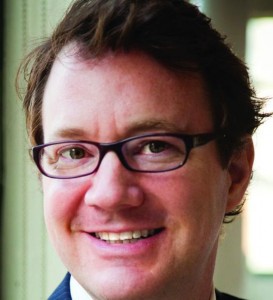If you want something done right, do it yourself.
 John Keefe will discuss how data journalists can use new mobile technology to gather their own data and better cover issues that affect their communities on a panel at SXSW Interactive.
John Keefe will discuss how data journalists can use new mobile technology to gather their own data and better cover issues that affect their communities on a panel at SXSW Interactive.
As senior editor for data news and journalism at WNYC-New York, Keefe works the station’s data news team to tell stories using data. Here he is showing off an interactive map designed to help users prepare for Hurricane Irene in 2011.
Data journalists combine traditional reporting skills with digital skills and statistical analysis to find meaningful trends and stories within data and present those stories in meaningful ways.
Most data journalists rely on third parties, particularly government agencies, for the data they need. But according to Keefe, that data may be incomplete or in a format data journalists can’t really use.
“Data is only as good as the methods used to collect and analyze and error check along the way,” he said. “All data can be problematic in some way or another.”
The biggest issue, Keefe says, is that there isn’t always someone collecting the data reporters may need to cover issues that face their communities. For the media to perform their “watch-dog” function, they should look for ways to gather important inforamtion that may not be available already.
That’s what Keefe says he hopes to discuss in this panel, Sensoring the News: Detector-Driven Journalism.
Also on the panel are Matt Waite, professor of practice at the University of Nebraska-Lincoln; Sarah Williams, assistant professor and director of the Civic Data Design Project at Massachusetts Institute of Technology; and Nadav Aharony, co-founder and CEO of Behavio.
Behavio, a 2012 Knight News Challenge winner, is working on a number of tools to help mobile app developers and users explore data trends using the sensors in mobile phones. Aharony will talk more about these upcoming tools during the panel.
Mobile phones have a number of sensors, Keefe said, from thermometers to GPS to compasses to microphones and more. The right software–like the kind Behavio is developing–can turn smartphones into detectors.
Keefe said he’ll discuss a few new projects his team at WNYC is working on using these kind of tools and involving the community in a kind of crowd sourcing effort to gather primary data.
“The neat thing for us is that anyone can do this stuff, especially using the kind of tools (Aharony) is developing,” he said.
The broad selection of journalists, hackers and makers who attend SXSW Interactive will hopefully make for a collaborative panel, Keefe said. He hopes to have an interactive discussion and hear about attendees’ ideas for these technologies.
Sensoring the News: Detector-Driven Journalism is scheduled for Monday, March 11, at 3:30 p.m. in the Longhorn room at the Omni Downtown.
